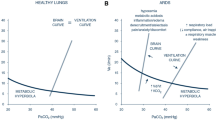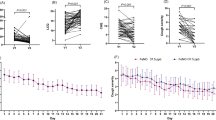Abstract
Bronchial responsiveness to methacholine or histamine increases at night and may contribute to the mechanisms of nocturnal asthma. Hypertonic saline (HS) is a more clinically relevant stimulus for the diagnosis and assessment of the severity of asthma, but the circadian variation in bronchial responsiveness to hypertonic challenges has not been addressed. The aim of this study was to compare the responsiveness to hypertonic saline at 4:00 AM and at 4:00 PM. Eighteen diurnally active patients (11 women) with asthma, 31 ± 9 years of age (mean ± SD) and with a forced expiratory volume in 1 s (FEV1) of 79.11% ± 12.85%, underwent two challenge tests (4:00 AM and 4:00 PM) in random sequence separated by an interval of 7 days. The challenge test consisted of inhalations of 4.5% saline with increasing doses by doubling the duration of nebulization (0.5, 1, 2, 4, and 8 min). The inhalation continued until a drop of 20% in FEV1 was achieved or total time of 15.5 min. The provocative dose that caused the 20% drop in FEV1 (PD20) was calculated. Differences were found between 4:00 PM and 4:00 AM values for inhalation times [3.80 ± 3.57 min and 2.19 ± 2.42 min (p = 0.001), respectively] and for PD20 [4.94 ± 6.77 ml and 2.93 ± 4.74 ml (p = 0.002), respectively]. Eight patients with a home-assessed nocturnal peak expiratory flow (PEF) drop of more than 15% formed the nocturnal asthma group. The behavior of these patients was similar to that of the non-nocturnal asthma group. We conclude that the bronchial responsiveness to HS increases at night.


Similar content being viewed by others
Abbreviations
- HS:
-
hypertonic saline
- FEV1 :
-
forced expiratory volume in 1 s
- PD20 :
-
provocative dose causing 20% drop in FEV1
- PEF:
-
peak expiratory flow
- IQR:
-
interquartile range
References
American Thoracic Society (1991) Medical section of the American Lung Association. Am Rev Respir Dis 144:1202–1218
American Thoracic Society (2000) Guidelines for methacholine and exercise challenge testing—1999. Am J Respir Crit Care Med 161:309–329
Anderson SD, Brannan JD (2003) Methods for “indirect” challenge tests including exercise, eucapnic voluntary hyperpnea, and hypertonic aerosols. Clin Rev Allergy Immunol 24:27–54
Beam WR, Weiner DE, Martin RJ (1992) Timing of prednisone and alterations of airway inflammation in nocturnal asthma. Am Rev Respir Dis 146:1524–1530
Benedito-Silva AA, Menna-Barreto L, Marques N, Tenreiro S (1990) A self-assessment questionnaire for the determination of morningness–eveningness types in Brazil. Prog Clin Biol Res 314:89–98
Bonnet R, Jörres R, Heitmann U, Magnussen H (1991) Circadian rhythm in airway responsiveness and airway tone in patients with mild asthma. J Appl Physiol 71:1598–1605
Cockcroft DW (2001) How best to measure airway responsiveness? Am J Respir Crit Care Med 163:1514–1515
Frezza G, Terra-Filho J, Martinez JAB, Vianna EO (2003) Rapid effect of inhaled steroids on nocturnal worsening of asthma. Thorax 58:632–633
Gibson PG, Henry R, Shah S, et al. (2000) Validation of the ISAAC video questionnaire (AVQ3.0) in adolescents from a mixed ethnic background. Clin Exp Allergy 30:1181–1187
Horne JA, Östberg O (1976) A self-assessment questionnaire to determine morningness–eveningness in human circadian rhythms. Int J Chronobiol 4:97–110
Irwin RS, French CT, Smyrnios NA, Curley FJ (1997) Interpretation of positive results of a methacholine inhalation challenge and 1 week of inhaled bronchodilator use in diagnosis and treating cough-variant asthma. Arch Intern Med 157:1981–1987
Jarjour NN (1999) Circadian variation in allergen and nonspecific bronchial responsiveness in asthma. Chronobiol Int 16:631–639
Joos GF, O’Connor B (2003) Indirect airway challenges. Eur Respir J 21:1050–1068
Kondo S, Abe K (1991) Priority of peak circadian variation of bronchial responsiveness to the trough of circadian variation of bronchial caliber in asthmatic children. Chest 100:640–643
Martin RJ (1999) Location of airway inflammation in asthma and the relationship to circadian change in lung function. Chronobiol Int 16:623–630
Martin RJ, Cicutto LC, Ballard RD (1990) Factors related to the nocturnal worsening of asthma. Am Rev Respir Dis 141:33–38
Martin RJ, Cicutto LC, Smith HR, Ballard RD, Szefler SJ (1991) Airways inflammation in nocturnal asthma? Am Rev Respir Dis 143:351–357
Paggiaro PL (2002) Sputum induction. Eur Respir J 20:3s–8s
Pincus DJ, Szefler SJ, Ackeson LM, Martin RJ (1995) Chronotherapy of asthma with inhaled steroids: the effect of dosage timing on drug efficacy. J Allergy Clin Immunol 95:1172–1178
Pincus DJ, Humeston TR, Martin RJ (1997) Further studies on the chronotherapy of asthma with inhaled steroids: the effect of dosage timing on drug efficacy. J Allergy Clin Immunol 100:771–774
Riedler J, Robertson CF (1994) Effect of tidal volume on the output and particle size distribution of hypertonic saline from an ultrasonic nebulizer. Eur Respir J 7:998–1002
Riedler J, Reade T, Dalton M, Holst D, Robertson C (1994) Hypertonic saline challenge in an epidemiologic survey of asthma in children. Am J Respir Crit Care Med 50:1632–1639
Riedler J, Gamper A, Eder W, Oberfeld G (1998) Prevalence of bronchial hyperresponsiveness to 4.5% saline and its relation to asthma and allergy symptoms in Austrian children. Eur Respir J 11:355–360
Sly PD, Landau LI (1986) Diurnal variation in bronchial responsiveness in children. Pediatr Pulmonol 2:344–352
Smith CM, Anderson SD (1990) Inhalation challenge using hypertonic saline in asthmatic subjects: a comparison with responses to hyperpnoea, methacholine and water. Eur Respir J 3:144–151
Stefano A, Lusuardi M, Braghiroli A, Donner CF (1997) Nocturnal asthma: mechanisms and therapy. Lung 175:53–61
Van Schoor J, Joos GF, Pauwels RA (2000) Indirect bronchial hyperresponsiveness in asthma: mechanisms, pharmacology and implications for clinical research. Eur Respir J 16:514–533
Vianna EO, Boaventura LC, Terra-Filho J, et al. (2002) Morning-to-evening variation in exercise-induced bronchospasm. J Allergy Clin Immunol 110:236–240
Vries K, Goei JT, Booy-Noord H, Orie NGM (1962) Changes during 24 hours in the lung function and histamine hyperreactivity of the bronchial tree in asthmatic and bronchitic patients. Int Arch Allergy Immunol 20:93–101
Acknowledgments
The authors thank Dr. Sandra Anderson and Dr. Conceição Santos (Royal Prince Alfred Hospital, Australia) for helping us set up the HS challenge procedure. This work was supported by grants 98/10382-6 and 02/12247-6 from the São Paulo State Government (FAPESP), Brazil.
Author information
Authors and Affiliations
Corresponding author
Rights and permissions
About this article
Cite this article
Ferraz, E., Borges, M.C., Terra-Filho, J. et al. Comparison of 4 AM and 4 PM Bronchial Responsiveness to Hypertonic Saline in Asthma. Lung 184, 341–346 (2006). https://doi.org/10.1007/s00408-006-0017-0
Accepted:
Published:
Issue Date:
DOI: https://doi.org/10.1007/s00408-006-0017-0




